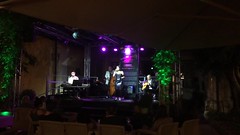A few, brief considerations on George Siemens‘ thoughts regarding connectivism and learning. A review more than anything: I enjoyed his keynotes at Sagrado so very much, and even more the informal talks we had together with students and friends, and his ideas stayed on the top of my mind mingling with my own. Now I have at last the time to put them in writing, or to make them explicit, as he’d say. Thanks George, it’s been a pleasure and great learning.
Making connections between ideas is what’s most important for learning. Perhaps, like Kevin Kelly says, ideas themselves are connections (see Where Ideas Come From on Wired). Also, Minsky, Papert and Alan Kay all stated that the goal of education is to create powerful, passionate, deep connections.
Thus, I remembered a connection I developed in my mind when I prepared myself for the prequel to Siemens’ talk at Sagrado (PDF of his presentation here). I was asked by organizer friend Dr. Rosa Ojeda (the Woman Who Brought Siemens to Puerto Rico) to prepare the terrain, together with friend José Sánchez. So, I started to read papers, to re-read some of Siemens’ writings (including his book Knowing Knowledge). What happened? I started forming ideas on what I was reading, so I took notes: just lumps of words on a piece of paper or a computer note (I didn’t have yet the iPhone note-taking system!). Then I read Kevin Kelly and Johnson’s interview on Wired, on how ideas develop. And click: First connection. Ideas are connections? Learning means making connections? Wow, I was there, making connections (about connections!), and learning. Alone. With No Teacher.
Alone? Not at all. My friend Mario Núñez would say that even when utterly alone I am accompanied by myself, so it’s always the two of us who are studying and learning. OK. But then I found myself and me adding up a few people to the idea network which was forming: Rosa, José, some other friends who flirt with these ideas, and yes, Siemens himself. Now, this is certainly spectacular. Imagine the party I would have thrown when I was a university student, if I could have added Alan Turing to my personal learning network. WOW! But this is exactly what I was doing. So it goes with connections! Alone. With No Teacher. But… Wait! Perhaps the teacher’s role was taken by the network. Could it be?
This connection business is not really new. Our new tech allows us to bring connection-making to the next level and to every human being on the planet. Darwin, when researching, was making and fostering connections with his peers, to exchange ideas, and to put them to test, like all good scientists do. Thus, actually scientists do connection work all the time, when they do science. Artists too, actually. This a very strong tie between arts and science. Which is missing from education. We don’t do science with our students: We teach them facts, chunks of knowledge. Then what? We don’t do art either: instead, we talk about art all the time.
Siemens calls this connection-driven process, realtime global collaborative sense-making. I love this definition. Remember when in school you asked your desk mate “What has the teacher just said?” You tried to make sense of whatever content socially. Thus, students, suggested Siemens, must be brought to believe they’ll need others to make sense of learning materials. Thus, we need openness, or students/people will find walls around areas of the network they may need to navigate. The beauty of openness, says Siemens, is that it produces more and more of itself!
Since network content is fragmented/loose, it needs coherence to be created — Coherence is thus the added-value students must attach to chunks of information to form networks of comprehension. Or better, coherence is the glue that keeps the pieces together and permits to create a whole picture. Necessarily, coherence is a socially-constructed property of knowledge networks.
By asking students to make things explicit (blog, tweet, forums, talking, etc) we may help them create coherence in the mental map of concepts beiong learned/studied. This way, students are also compelled to say what they have in their mind. And we as teachers have a way to correct them, to expose their logic fallacies, to engage them in critical analysis.
But to do this, says Siemens we need time. Time to think, to make them think.
And we agree. Time and Openness. Is there value in what we do as teachers if we do not work in an environment that supports both?





Pingback: Convergencia cognitiva: Explorando la Interacción entre la Inteligencia Artificial y la Inteligencia Humana en la Educación Disruptiva (II) – juandon. Innovación y conocimiento
Pingback: Construyendo las SOFT SKILLS en entornos de aprendizaje disruptivos con el soporte de la IA – juandon. Innovación y conocimiento
Pingback: «El papel de los algoritmos en la educación digital: una herramienta para el empoderamiento del estudiante» – juandon. Innovación y conocimiento
Pingback: La democratización de la realidad virtual inmersiva ha aumentado la accesibilidad y asequibilidad del aprendizaje en todas sus variantes. (procesos, evidencias científicas, prácticas, políticas…) (metaverso y simulaciones) – juandon. Inno
Pingback: La transparencia y el desafío crítico, ejes del nuevo aprendizaje redárquico – juandon. Innovación y conocimiento
Pingback: La democratización de la realidad virtual inmersiva ha aumentado la accesibilidad y asequibilidad del aprendizaje en todas sus variantes. (procesos, evidencias científicas, prácticas, políticas…) – juandon. Innovación y conocimiento
Pingback: Trabajamos con ambientes (virtuales –AVA) de aprendizaje para desarrollar la base de un aprendizaje mixto e inmersivo… – juandon. Innovación y conocimiento
Pingback: LA CREACION DE ESCENARIOS DE APRENDIZAJE, ANTESALA DE LA EDUCACION DISRUPTIVA – Epignosys STUDIO LAB
Pingback: LA CREACION DE ESCENARIOS DE APRENDIZAJE, ANTESALA DE LA EDUCACION DISRUPTIVA – juandon. Innovación y conocimiento
Pingback: Creación de escenarios de aprendizaje: virtualidad inmersiva y simulación como ejes de desarrollo y evolución – Epignosys STUDIO LAB
Pingback: Creación de escenarios de aprendizaje: virtualidad inmersiva y simulación como ejes de desarrollo y evolución – juandon. Innovación y conocimiento
Pingback: SIMULANDO ESCENARIOS DE APRENDIZAJE: buscando la excelencia personalizada con la realidad virtual, aumentada, inteligencia artificial… – juandon. Innovación y conocimiento
Pingback: Trabajando en escenarios creativos de un nuevo paradigma educo-social y tecnológico – juandon. Innovación y conocimiento
Pingback: Los procesos abiertos, inclusivos y ubícuos superan el pensamiento de diseño formando parte indiscutible de la Educación Disruptiva – juandon. Innovación y conocimiento
Pingback: Espacios y escenarios de aprendizaje autorregulados: lugares, no lugares, internet,… (Educación Disruptiva) – juandon. Innovación y conocimiento